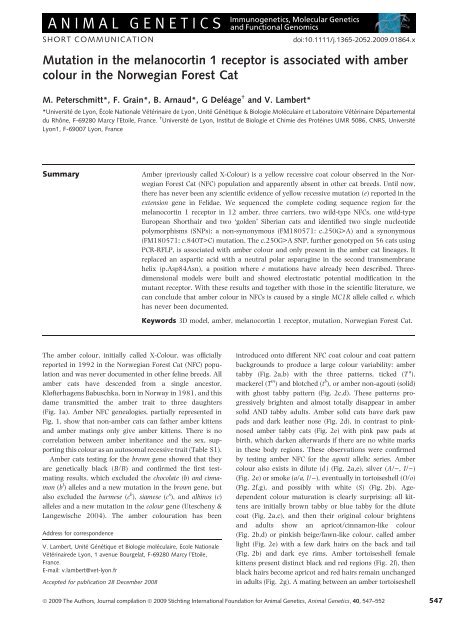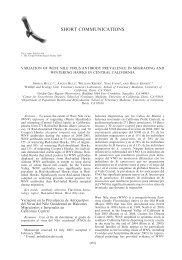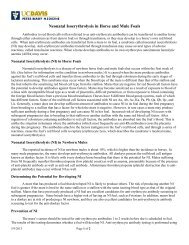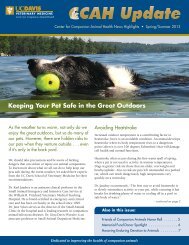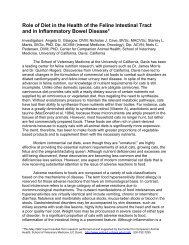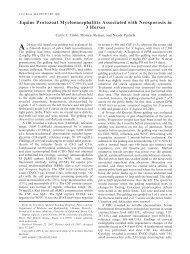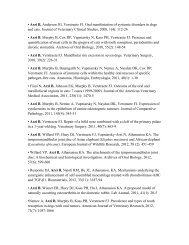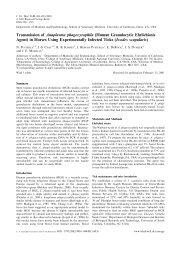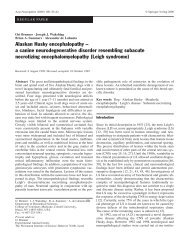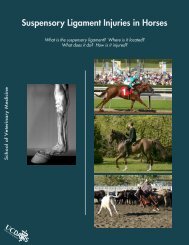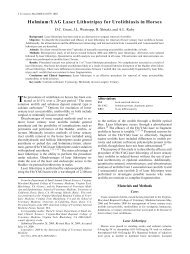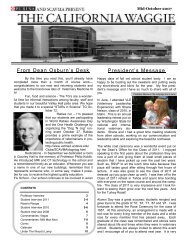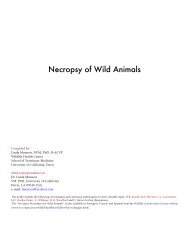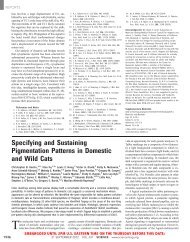Mutation in the melanocortin 1 receptor is associated with amber ...
Mutation in the melanocortin 1 receptor is associated with amber ...
Mutation in the melanocortin 1 receptor is associated with amber ...
You also want an ePaper? Increase the reach of your titles
YUMPU automatically turns print PDFs into web optimized ePapers that Google loves.
SHORT COMMUNICATION doi:10.1111/j.1365-2052.2009.01864.x<br />
<strong>Mutation</strong> <strong>in</strong> <strong>the</strong> melanocort<strong>in</strong> 1 <strong>receptor</strong> <strong>is</strong> <strong>associated</strong> <strong>with</strong> <strong>amber</strong><br />
colour <strong>in</strong> <strong>the</strong> Norwegian Forest Cat<br />
M. Peterschmitt*, F. Gra<strong>in</strong>*, B. Arnaud*, G Deléage † and V. L<strong>amber</strong>t*<br />
*Université de Lyon, École Nationale Vétér<strong>in</strong>aire de Lyon, Unité Génétique & Biologie Moléculaire et Laboratoire Vétér<strong>in</strong>aire Départemental<br />
du Rhône, F-69280 Marcy lÕEtoile, France. † Université de Lyon, Institut de Biologie et Chimie des Proté<strong>in</strong>es UMR 5086, CNRS, Université<br />
Lyon1, F-69007 Lyon, France<br />
Summary Amber (previously called X-Colour) <strong>is</strong> a yellow recessive coat colour observed <strong>in</strong> <strong>the</strong> Norwegian<br />
Forest Cat (NFC) population and apparently absent <strong>in</strong> o<strong>the</strong>r cat breeds. Until now,<br />
<strong>the</strong>re has never been any scientific evidence of yellow recessive mutation (e) reported <strong>in</strong> <strong>the</strong><br />
extension gene <strong>in</strong> Felidae. We sequenced <strong>the</strong> complete cod<strong>in</strong>g sequence region for <strong>the</strong><br />
melanocort<strong>in</strong> 1 <strong>receptor</strong> <strong>in</strong> 12 <strong>amber</strong>, three carriers, two wild-type NFCs, one wild-type<br />
European Shorthair and two ÔgoldenÕ Siberian cats and identified two s<strong>in</strong>gle nucleotide<br />
polymorph<strong>is</strong>ms (SNPs): a non-synonymous (FM180571: c.250G>A) and a synonymous<br />
(FM180571: c.840T>C) mutation. The c.250G>A SNP, fur<strong>the</strong>r genotyped on 56 cats us<strong>in</strong>g<br />
PCR-RFLP, <strong>is</strong> <strong>associated</strong> <strong>with</strong> <strong>amber</strong> colour and only present <strong>in</strong> <strong>the</strong> <strong>amber</strong> cat l<strong>in</strong>eages. It<br />
replaced an aspartic acid <strong>with</strong> a neutral polar asparag<strong>in</strong>e <strong>in</strong> <strong>the</strong> second transmembrane<br />
helix (p.Asp84Asn), a position where e mutations have already been described. Threedimensional<br />
models were built and showed electrostatic potential modification <strong>in</strong> <strong>the</strong><br />
mutant <strong>receptor</strong>. With <strong>the</strong>se results and toge<strong>the</strong>r <strong>with</strong> those <strong>in</strong> <strong>the</strong> scientific literature, we<br />
can conclude that <strong>amber</strong> colour <strong>in</strong> NFCs <strong>is</strong> caused by a s<strong>in</strong>gle MC1R allele called e, which<br />
has never been documented.<br />
The <strong>amber</strong> colour, <strong>in</strong>itially called X-Colour, was officially<br />
reported <strong>in</strong> 1992 <strong>in</strong> <strong>the</strong> Norwegian Forest Cat (NFC) population<br />
and was never documented <strong>in</strong> o<strong>the</strong>r fel<strong>in</strong>e breeds. All<br />
<strong>amber</strong> cats have descended from a s<strong>in</strong>gle ancestor,<br />
Kløfterhagens Babuschka, born <strong>in</strong> Norway <strong>in</strong> 1981, and th<strong>is</strong><br />
dame transmitted <strong>the</strong> <strong>amber</strong> trait to three daughters<br />
(Fig. 1a). Amber NFC genealogies, partially represented <strong>in</strong><br />
Fig. 1, show that non-<strong>amber</strong> cats can fa<strong>the</strong>r <strong>amber</strong> kittens<br />
and <strong>amber</strong> mat<strong>in</strong>gs only give <strong>amber</strong> kittens. There <strong>is</strong> no<br />
correlation between <strong>amber</strong> <strong>in</strong>heritance and <strong>the</strong> sex, support<strong>in</strong>g<br />
th<strong>is</strong> colour as an autosomal recessive trait (Table S1).<br />
Amber cats test<strong>in</strong>g for <strong>the</strong> brown gene showed that <strong>the</strong>y<br />
are genetically black (B/B) and confirmed <strong>the</strong> first testmat<strong>in</strong>g<br />
results, which excluded <strong>the</strong> chocolate (b) and c<strong>in</strong>namon<br />
(b l ) alleles and a new mutation <strong>in</strong> <strong>the</strong> brown gene, but<br />
also excluded <strong>the</strong> burmese (c b ), siamese (c s ), and alb<strong>in</strong>os (c)<br />
alleles and a new mutation <strong>in</strong> <strong>the</strong> colour gene (Utescheny &<br />
Langew<strong>is</strong>che 2004). The <strong>amber</strong> colouration has been<br />
Address for correspondence<br />
V. L<strong>amber</strong>t, Unité Génétique et Biologie moléculaire, Ecole Nationale<br />
Vétér<strong>in</strong>airede Lyon, 1 avenue Bourgelat, F-69280 Marcy lÕEtoile,<br />
France.<br />
E-mail: v.l<strong>amber</strong>t@vet-lyon.fr<br />
Accepted for publication 28 December 2008<br />
Keywords 3D model, <strong>amber</strong>, melanocort<strong>in</strong> 1 <strong>receptor</strong>, mutation, Norwegian Forest Cat.<br />
<strong>in</strong>troduced onto different NFC coat colour and coat pattern<br />
backgrounds to produce a large colour variability: <strong>amber</strong><br />
tabby (Fig. 2a,b) <strong>with</strong> <strong>the</strong> three patterns, ticked (T a ),<br />
mackerel (T m ) and blotched (t b ), or <strong>amber</strong> non-agouti (solid)<br />
<strong>with</strong> ghost tabby pattern (Fig. 2c,d). These patterns progressively<br />
brighten and almost totally d<strong>is</strong>appear <strong>in</strong> <strong>amber</strong><br />
solid AND tabby adults. Amber solid cats have dark paw<br />
pads and dark lea<strong>the</strong>r nose (Fig. 2d), <strong>in</strong> contrast to p<strong>in</strong>knosed<br />
<strong>amber</strong> tabby cats (Fig. 2e) <strong>with</strong> p<strong>in</strong>k paw pads at<br />
birth, which darken afterwards if <strong>the</strong>re are no white marks<br />
<strong>in</strong> <strong>the</strong>se body regions. These observations were confirmed<br />
by test<strong>in</strong>g <strong>amber</strong> NFC for <strong>the</strong> agouti allelic series. Amber<br />
colour also ex<strong>is</strong>ts <strong>in</strong> dilute (d ) (Fig. 2a,e), silver (A/), I/))<br />
(Fig. 2e) or smoke (a/a, I/)), eventually <strong>in</strong> torto<strong>is</strong>eshell (O/o)<br />
(Fig. 2f,g), and possibly <strong>with</strong> white (S) (Fig. 2b). Agedependent<br />
colour maturation <strong>is</strong> clearly surpr<strong>is</strong><strong>in</strong>g; all kittens<br />
are <strong>in</strong>itially brown tabby or blue tabby for <strong>the</strong> dilute<br />
coat (Fig. 2a,c), and <strong>the</strong>n <strong>the</strong>ir orig<strong>in</strong>al colour brightens<br />
and adults show an apricot/c<strong>in</strong>namon-like colour<br />
(Fig. 2b,d) or p<strong>in</strong>k<strong>is</strong>h beige/fawn-like colour, called <strong>amber</strong><br />
light (Fig. 2e) <strong>with</strong> a few dark hairs on <strong>the</strong> back and tail<br />
(Fig. 2b) and dark eye rims. Amber torto<strong>is</strong>eshell female<br />
kittens present d<strong>is</strong>t<strong>in</strong>ct black and red regions (Fig. 2f), <strong>the</strong>n<br />
black hairs become apricot and red hairs rema<strong>in</strong> unchanged<br />
<strong>in</strong> adults (Fig. 2g). A mat<strong>in</strong>g between an <strong>amber</strong> torto<strong>is</strong>eshell<br />
Ó 2009 The Authors, Journal compilation Ó 2009 Sticht<strong>in</strong>g International Foundation for Animal Genetics, Animal Genetics, 40, 547–552 547
548<br />
Peterschmitt et al.<br />
(a)<br />
(c)<br />
Figure 1 Pedigree analys<strong>is</strong> of <strong>amber</strong> NFC l<strong>in</strong>eages. (a) Swed<strong>is</strong>h l<strong>in</strong>eage; (b) Dutch l<strong>in</strong>eage; (c) German l<strong>in</strong>eage. Circles represent females, squares<br />
represent males. Is<strong>is</strong>, DeaDia and Froy Sparetta av Aesene are daughters from <strong>the</strong> first <strong>amber</strong> carrier, Kløfterhagens Babuschka. These three<br />
daughters were very probably <strong>amber</strong> carriers. Numbers <strong>with</strong><strong>in</strong> <strong>the</strong> symbols represent <strong>the</strong> same cats <strong>in</strong> each l<strong>in</strong>eage. Half-coloured symbols represent<br />
<strong>amber</strong> carrier cats, coloured symbols represent homozygous <strong>amber</strong> cats. Wild-type non-<strong>amber</strong> carrier cats have not been represented for<br />
simplification. In figure (c), R1 and R2 cats are phenotypically red. Their parents are <strong>amber</strong> homozygous c.250AA; <strong>the</strong> mo<strong>the</strong>r (N°16) <strong>is</strong> an <strong>amber</strong><br />
torto<strong>is</strong>eshell dame. ¥ cats whose MC1R region was sequenced (15 animals); *certa<strong>in</strong> cats whose MC1R region was genotyped by PCR-RFLP (13<br />
animals), o<strong>the</strong>r tested cats share common ancestors.<br />
dame and an <strong>amber</strong> sire gave two <strong>amber</strong> females and two<br />
red males (see cats R1 and R2 <strong>in</strong> Fig. 1c). Th<strong>is</strong> result proves<br />
that <strong>the</strong> orange allele <strong>is</strong> ep<strong>is</strong>tatic to <strong>amber</strong>, because <strong>the</strong>se six<br />
cats are all homozygous for <strong>the</strong> <strong>amber</strong> allele <strong>in</strong>clud<strong>in</strong>g <strong>the</strong><br />
two red male kittens. Therefore, <strong>the</strong> <strong>amber</strong> pigment <strong>is</strong> different<br />
from <strong>the</strong> trichochrome red pigment, and <strong>is</strong> probably<br />
ano<strong>the</strong>r sulphur-enriched pigment (yellow phaeomelan<strong>in</strong>),<br />
which seems to replace most of <strong>the</strong> hair eumelan<strong>in</strong> black<br />
pigment.<br />
Diversity <strong>in</strong> mammalian pigmentation <strong>is</strong> achieved by<br />
differential expression and regional d<strong>is</strong>tribution of two pigment<br />
types: black eumelan<strong>in</strong> and yellow phaeomelan<strong>in</strong>.<br />
Switch<strong>in</strong>g between both syn<strong>the</strong>ses <strong>is</strong> regulated by a paracr<strong>in</strong>e<br />
signall<strong>in</strong>g molecule, <strong>the</strong> agouti prote<strong>in</strong> act<strong>in</strong>g as an<br />
antagon<strong>is</strong>t for <strong>the</strong> melanocort<strong>in</strong> 1 <strong>receptor</strong> (MC1-R). MC1-R<br />
(b)<br />
<strong>is</strong> a seven transmembrane prote<strong>in</strong> encoded by <strong>the</strong> extension<br />
gene, expressed on melanocytes and enabl<strong>in</strong>g eumelan<strong>in</strong><br />
syn<strong>the</strong>s<strong>is</strong> because of alpha-melanocyte stimulat<strong>in</strong>g hormone<br />
(a-MSH) (Robb<strong>in</strong>s et al. 1993). In mammals, extension<br />
mutations caus<strong>in</strong>g constitutively active <strong>receptor</strong>s (E D ) are<br />
dom<strong>in</strong>ant over <strong>the</strong> wild-type allele (E + ) and produce black<br />
coat, <strong>in</strong> contrast to <strong>in</strong>activat<strong>in</strong>g recessive mutations (e),<br />
which result <strong>in</strong> yellow pigmentation (Klungland & Va˚ge<br />
2003). These <strong>in</strong>activat<strong>in</strong>g e mutations enable a large colour<br />
variability from <strong>the</strong> ÔKermodeÕ black bear white-phased coat<br />
(Ritland et al. 2001) to <strong>the</strong> mouse tawny coat (Jackson<br />
1994) and red coat possibly observed <strong>in</strong> dogs, humans (Rees<br />
2003), pigs, chickens and horses (Andersson 2003). Such e<br />
mutation has never been described <strong>in</strong> Felidae, whereas<br />
dom<strong>in</strong>ant E D mutations are known <strong>in</strong> jaguar and<br />
Ó 2009 The Authors, Journal compilation Ó 2009 Sticht<strong>in</strong>g International Foundation for Animal Genetics, Animal Genetics, 40, 547–552
(a)<br />
jaguarundi (Eizirik et al. 2003) and are supposed to have<br />
ex<strong>is</strong>ted <strong>in</strong> domestic cat (Vella et al. 1999).<br />
As it <strong>is</strong> a yellow recessive coat colour, we hypo<strong>the</strong>sized<br />
that th<strong>is</strong> new colour <strong>in</strong> NFC could be <strong>the</strong> first mutation <strong>in</strong><br />
<strong>the</strong> fel<strong>in</strong>e extension gene, cod<strong>in</strong>g for <strong>the</strong> MC1-R. Moreover,<br />
<strong>the</strong> yellow recessive mutation <strong>is</strong> only expressed <strong>in</strong> follicular<br />
melanocytes and has no consequence on epidermal melanocytes<br />
<strong>in</strong> dogs (Schmutz et al. 2002), as observed <strong>in</strong> <strong>amber</strong><br />
cats (e.g. dark paw pads).<br />
We worked <strong>with</strong> three wild-type cats (two NFC and one<br />
European Shorthair), 33 <strong>amber</strong> NFC, 36 carrier NFC and<br />
four ÔgoldenÕ Siberian cats. Genomic DNA was extracted<br />
ei<strong>the</strong>r <strong>with</strong> NucleoSp<strong>in</strong> Blood Quick Pure Ò kit (blood samples)<br />
or NucleoSp<strong>in</strong> XS T<strong>is</strong>sueÒ kit (hair samples) (Macherey<br />
Nagel). We sequenced <strong>the</strong> MC1R complete cod<strong>in</strong>g<br />
sequence region (954 bp) <strong>in</strong> 12 <strong>amber</strong>, three carriers, two<br />
wild-type NFCs, one wild-type European Shorthair and two<br />
ÔgoldenÕ Siberian cats after PCR amplification. The MC1R<br />
gene sequenc<strong>in</strong>g d<strong>is</strong>played <strong>in</strong> all sequences <strong>the</strong> same silent<br />
SNP FM180571: c.840T>C <strong>in</strong> relation to Fel<strong>is</strong> catus wildtype<br />
MC1R gene (AY237395). We also identified a nonsynonymous<br />
FM180571: c.250G>A, only detected <strong>in</strong> cats<br />
from <strong>amber</strong> l<strong>in</strong>eages. SNP c.250G>A was <strong>the</strong>n genotyped<br />
on 56 additional cat samples (54 NFC and two ÔgoldenÕ<br />
Siberian cats) by RFLP-PCR us<strong>in</strong>g BstXI (Fermentas) and<br />
Hpy188I (New England Biolabs), which cleave <strong>the</strong> c.250A<br />
and <strong>the</strong> c.250G alleles respectively. Primers forward<br />
(b) (c)<br />
(d) (e) (f) (g)<br />
MC1R mutation <strong>in</strong> domestic cats 549<br />
Figure 2 Photographs and selected genotypes illustrat<strong>in</strong>g <strong>the</strong> variety of <strong>amber</strong> colours <strong>in</strong> <strong>the</strong> NFCs. (a) A 4-week-old litter of three <strong>amber</strong><br />
blotched tabby (*), A/), D/), i/i, O/o, s/s, t b /t b and four light <strong>amber</strong> blotched tabby kittens (#), A/), d/d, i/i, O/o, s/s, t b /t b . Areas between <strong>the</strong><br />
black/blue tabby mark<strong>in</strong>gs are brown to apricot-coloured (*)/grey to beige (#). (b) Amber blotched tabby and white female at 16 months old,<br />
A/), D/), i/i, O/o, S/), t b /t b . She has an apricot-coloured coat <strong>with</strong> a tabby pattern ton<strong>in</strong>g down and a few rema<strong>in</strong><strong>in</strong>g black hairs on <strong>the</strong> tail (d, e).<br />
Her nose and paw pads are p<strong>in</strong>k because of white marks. (c) Amber solid 8-week-old kitten <strong>with</strong> dark nose, dark paw pads and ghost tabby<br />
pattern, a/a, D/), i/i, O/o, s/s, )/). (d) Same cat as picture C at 9 months old; note <strong>the</strong> tabby pattern ton<strong>in</strong>g down to an apricot-coloured<br />
coat <strong>with</strong> dark paw pads and nose. (e) Amber light silver mackerel tabby female <strong>with</strong> little white on <strong>the</strong> breast at 10 months old, A/), d/d, I/),<br />
O/o, S/), T m /). She has a light p<strong>in</strong>k<strong>is</strong>h-beige colour and her tabby pattern <strong>is</strong> already toned down. (f) Amber silver torto<strong>is</strong>eshell mackerel tabby<br />
and white female at 8 weeks old, A/), D/), I/), O/o, S/), T m /). Differentiation between orange (e.g. left forelimb) and <strong>amber</strong> <strong>is</strong> still easy.<br />
(g) Same cat as figure (f) at 12 months old: dark stripes brightened and became tawny, m<strong>is</strong>takable for orange areas (e.g. right back limb).<br />
(5¢-TGCTGGGCTCCCTCAACTC-3¢) and reverse (5¢-CCAG<br />
CACGTCAATGATGTCG-3¢) were designed to amplify a 342bp<br />
fragment (29–370). Amber cats were all homozygous<br />
c.250AA, whereas carriers were all heterozygous c.250GA.<br />
Th<strong>is</strong> mutation <strong>associated</strong> <strong>with</strong> <strong>the</strong> <strong>amber</strong> colour <strong>in</strong> NFC has<br />
been called e.<br />
Eizirik et al. (2003) sequenced <strong>the</strong> MC1R cod<strong>in</strong>g gene<br />
from 43 cats of various breeds. All had <strong>the</strong> same gene<br />
sequence (AY237395) <strong>in</strong>clud<strong>in</strong>g cats com<strong>in</strong>g from European<br />
breeds and ma<strong>in</strong>ly NFC. Never<strong>the</strong>less, <strong>the</strong> silent<br />
c.840T>C SNP could be widespread <strong>in</strong> European cats and<br />
th<strong>is</strong> warrants fur<strong>the</strong>r phylogenetic analys<strong>is</strong>.<br />
The c.250G>A mutation replaces an aspartic acid at<br />
position 84 <strong>with</strong> an asparag<strong>in</strong>e (p.Asp84Asn) and showed<br />
complete l<strong>in</strong>kage <strong>with</strong> <strong>amber</strong> colour AND <strong>amber</strong> carrier<br />
cats, from all <strong>amber</strong> European l<strong>in</strong>eages (Fig. 1), some of<br />
which were related to <strong>the</strong> first <strong>amber</strong> NFC. Similar m<strong>is</strong>sense<br />
substitutions have already been described <strong>in</strong> humans,<br />
(p.Asp84Glu) <strong>associated</strong> <strong>with</strong> red hair (Valverde et al.<br />
1995), and <strong>in</strong> horses, (p.Ser83Phe) cod<strong>in</strong>g for <strong>the</strong> chestnut<br />
coat (Marklund et al. 1996). Both mutations destabilize <strong>the</strong><br />
alpha-helix structure <strong>in</strong> <strong>the</strong> fundamental second transmembrane<br />
field whose am<strong>in</strong>o acid sequence <strong>is</strong> well conserved<br />
among <strong>the</strong> MC1-R from different species (Fig. 3). The<br />
human p.Asp84Glu variant was reported <strong>in</strong> several MC1R<br />
cod<strong>in</strong>g region sequenc<strong>in</strong>g studies but <strong>with</strong> d<strong>is</strong>crepant f<strong>in</strong>d<strong>in</strong>gs,<br />
because it was not always significantly <strong>associated</strong> <strong>with</strong><br />
Ó 2009 The Authors, Journal compilation Ó 2009 Sticht<strong>in</strong>g International Foundation for Animal Genetics, Animal Genetics, 40, 547–552
550<br />
Peterschmitt et al.<br />
Figure 3 Alignment of <strong>the</strong> prote<strong>in</strong> region encompass<strong>in</strong>g <strong>the</strong> MC1-R second transmembrane segment for 22 Rhodops<strong>in</strong> related G prote<strong>in</strong>-coupled<br />
<strong>receptor</strong>s. The multiple alignment was performed <strong>with</strong> <strong>the</strong> complete sequence by us<strong>in</strong>g CLUSTALW <strong>with</strong> default parameters, TM2 corresponds to <strong>the</strong><br />
second transmembrane field am<strong>in</strong>o acid sequence (residues 75–100). TM3 corresponds to <strong>the</strong> third transmembrane field am<strong>in</strong>o acid sequence<br />
(residues 114 to 144) (R<strong>in</strong>gholm et al. 2004). Light grey highlighted am<strong>in</strong>o acids are conserved residues <strong>in</strong> relation to <strong>the</strong> melanocort<strong>in</strong> 1 <strong>receptor</strong><br />
sequences. Dark highlighted aspartate (D) represents Asp84; dark grey-highlighted am<strong>in</strong>o acids represent respectively Glu94, Asp117 and Asp121<br />
accord<strong>in</strong>g to <strong>the</strong> MC1-R fel<strong>in</strong>e sequence (Q865E9). Accession numbers <strong>in</strong> <strong>the</strong> prote<strong>in</strong> database: MC1-R from cat (Q865E9), human (Q01726),<br />
mouse (Q01727), horse (P79166), wild boar (Q9TU05), rabbit (CAJ57384), cattle (NP_776533), sheep (CAA74298), dog (AAC33737), red fox<br />
(CAA62349), chicken (BAD91484), legless lizard (AAT90151) and zebraf<strong>is</strong>h (NP_851301); MC2-R from human (Q01718) and mouse (NP_032586);<br />
MC3-R from human (NP_063941) and mouse (NP_032587); MC4-R from human (P32245) and mouse (P56450); MC5-R from human (P33032)<br />
and mouse (P41149); Bov<strong>in</strong>e Rhodops<strong>in</strong> (NP_001014890).<br />
red hair <strong>in</strong> some studies (Rees 2003). Never<strong>the</strong>less, <strong>the</strong><br />
mutant p.Asp84Glu shows <strong>in</strong> vitro a slightly impaired ability<br />
to b<strong>in</strong>d <strong>the</strong> a-MSH (10-fold lower) and a much lower<br />
response to <strong>the</strong> melanocort<strong>in</strong>, as <strong>the</strong> maximum response <strong>is</strong><br />
only 15% of <strong>the</strong> wild-type MC1-R, prov<strong>in</strong>g that th<strong>is</strong> variant<br />
acts as a loss-of-function mutation (R<strong>in</strong>gholm et al. 2004).<br />
Even though <strong>the</strong> p.Asp84Glu mutant <strong>is</strong> known for a pred<strong>is</strong>position<br />
to sk<strong>in</strong> cancers <strong>in</strong> humans, th<strong>is</strong> effect probably<br />
does not ex<strong>is</strong>t <strong>in</strong> <strong>the</strong> <strong>amber</strong> cats. Indeed, <strong>the</strong> fel<strong>in</strong>e<br />
p.Asp84Asn mutation effects are only observed <strong>in</strong> <strong>the</strong> catÕs<br />
coat, contrary to <strong>the</strong> human p.Asp84Glu mutant, which <strong>is</strong><br />
<strong>associated</strong> <strong>with</strong> red hair and fair sk<strong>in</strong> (Rees 2003).<br />
The aspartate present at position 83 <strong>in</strong> <strong>the</strong> Bov<strong>in</strong>e Rhodops<strong>in</strong><br />
<strong>in</strong>teracts <strong>with</strong> o<strong>the</strong>r conserved am<strong>in</strong>o acids common<br />
to <strong>the</strong> Rhodops<strong>in</strong> related G prote<strong>in</strong>-coupled <strong>receptor</strong>s,<br />
form<strong>in</strong>g a hydrogen-b<strong>in</strong>d<strong>in</strong>g network. Th<strong>is</strong> network extends<br />
<strong>in</strong> <strong>the</strong> b<strong>in</strong>d<strong>in</strong>g pocket and has an important structural<br />
stabiliz<strong>in</strong>g role, and <strong>in</strong>deed a <strong>receptor</strong> activation role<br />
(Li et al. 2004). An alignment, performed on all MC1-R<br />
sequences from different species available <strong>in</strong> <strong>the</strong> prote<strong>in</strong><br />
database (more than 200, data not shown), <strong>in</strong>dicates that<br />
th<strong>is</strong> aspartic residue <strong>is</strong> also conserved <strong>in</strong> all sequences as<br />
well as <strong>in</strong> many melanocort<strong>in</strong> <strong>receptor</strong>s (Fig. 3). To check<br />
<strong>the</strong> impact of <strong>the</strong> p.Asp84Asn mutation, 3D models were<br />
built on <strong>the</strong> Geno3D server (Combet et al. 2002) us<strong>in</strong>g 2rh1<br />
as <strong>the</strong> template. The alignment (not shown) exhibited a<br />
30% identity, mak<strong>in</strong>g <strong>the</strong> modell<strong>in</strong>g reliable. The compar<strong>is</strong>on<br />
between <strong>the</strong> electrostatic potentials on <strong>the</strong> surfaces of<br />
<strong>the</strong> wild-type (Fig. 4a) and <strong>the</strong> mutant (Fig. 4b) models<br />
shows an important change at <strong>the</strong> bottom of <strong>the</strong> pocket. The<br />
wild-type pocket exhibits a greater negative potential (red<br />
patches) than <strong>the</strong> mutant. In cats, th<strong>is</strong> change <strong>in</strong> <strong>the</strong><br />
<strong>receptor</strong>-b<strong>in</strong>d<strong>in</strong>g moiety may expla<strong>in</strong> <strong>the</strong> expected decrease<br />
<strong>in</strong> aff<strong>in</strong>ity for <strong>the</strong> b<strong>in</strong>d<strong>in</strong>g of <strong>the</strong> positively charged a-MSH.<br />
In contrast, <strong>the</strong> human p.Asp84Glu mutation preserves <strong>the</strong><br />
electrostatic properties but adds a carbon to <strong>the</strong> side cha<strong>in</strong><br />
that may cause steric h<strong>in</strong>drance.<br />
Models represent<strong>in</strong>g <strong>the</strong> <strong>in</strong>teractions between a-MSH<br />
and human MC1-R have already been built and have<br />
emphasized <strong>the</strong> importance of <strong>the</strong> electrostatic potential for<br />
<strong>the</strong> b<strong>in</strong>d<strong>in</strong>g. Th<strong>is</strong> field delimits an acidic pocket between<br />
<strong>the</strong> glutamate 94 and <strong>the</strong> aspartates 117 and 121, which<br />
<strong>in</strong>teracts <strong>with</strong> <strong>the</strong> arg<strong>in</strong><strong>in</strong>e 8 from <strong>the</strong> a-MSH (Yang et al.<br />
1997). These three acidic residues (Glu94, Asp117 and<br />
Ó 2009 The Authors, Journal compilation Ó 2009 Sticht<strong>in</strong>g International Foundation for Animal Genetics, Animal Genetics, 40, 547–552
(a) (b)<br />
Asp121) are well conserved among <strong>the</strong> melanocort<strong>in</strong><br />
<strong>receptor</strong> am<strong>in</strong>o acid sequences from all species (Fig. 3).<br />
Fur<strong>the</strong>rmore, our 3D mutant model suggests that <strong>the</strong><br />
acidic residue at position 84 also <strong>in</strong>teracts <strong>in</strong> th<strong>is</strong> b<strong>in</strong>d<strong>in</strong>g,<br />
although <strong>the</strong> p.Asp84Asn replaces a negatively charged<br />
residue <strong>with</strong> a neutral polar one and thus only partially<br />
affects <strong>the</strong> a-MSH b<strong>in</strong>d<strong>in</strong>g. Th<strong>is</strong> could expla<strong>in</strong> why<br />
eumelanogenes<strong>is</strong> <strong>is</strong> <strong>in</strong>completely <strong>in</strong>hibited <strong>in</strong> <strong>amber</strong> NFC,<br />
as compared <strong>with</strong> e mutations <strong>in</strong> adult mice (Robb<strong>in</strong>s et al.<br />
1993) and <strong>in</strong> o<strong>the</strong>r species where no black hair <strong>is</strong><br />
observed. Ano<strong>the</strong>r hypo<strong>the</strong>s<strong>is</strong> would be that <strong>the</strong> aspartic<br />
acid 84 <strong>is</strong> functionally less critical for ligand b<strong>in</strong>d<strong>in</strong>g than<br />
<strong>the</strong> three previous residues (Glu94, Asp117 and Asp121).<br />
Th<strong>is</strong> MC1-R region <strong>is</strong> of great <strong>in</strong>terest for understand<strong>in</strong>g<br />
<strong>the</strong> <strong>receptor</strong> behaviour, because each mutation can have<br />
opposite consequences accord<strong>in</strong>g to its electrostatic<br />
modification. Indeed, <strong>the</strong> p.Glu92Lys (mur<strong>in</strong>e Glu92 <strong>is</strong><br />
equivalent to Glu94 <strong>in</strong> <strong>the</strong> human and fel<strong>in</strong>e MC1-R,<br />
Fig. 3) was <strong>in</strong>itially reported <strong>in</strong> mice to be a constitutive<br />
active mutation, which codes for a dom<strong>in</strong>ant black coat<br />
(Robb<strong>in</strong>s et al. 1993), <strong>in</strong> contrast to <strong>the</strong> fel<strong>in</strong>e p.Asp84Asn<br />
substitution, which <strong>is</strong> <strong>associated</strong> <strong>with</strong> a yellow colour.<br />
Thus, <strong>the</strong> mur<strong>in</strong>e p.Glu92Lys <strong>in</strong>troduces a positive charge<br />
<strong>in</strong>stead of <strong>the</strong> negative aspartic acid and <strong>in</strong>hibits <strong>the</strong><br />
a-MSH b<strong>in</strong>d<strong>in</strong>g, but also causes constitutive activation by<br />
mimick<strong>in</strong>g effects of <strong>the</strong> arg<strong>in</strong><strong>in</strong>e ligand on <strong>the</strong> b<strong>in</strong>d<strong>in</strong>g<br />
pocket conformation (Lu et al. 1998).<br />
As observed <strong>in</strong> dogs (Rees 2003) and <strong>in</strong> horses (Andersson<br />
2003), <strong>the</strong> fel<strong>in</strong>e e mutation enables <strong>the</strong> production of a<br />
large range of yellow colours, from tawny (Fig. 2g) to redapricot<br />
(Fig. 2d). In <strong>amber</strong> cats, th<strong>is</strong> variability could be due<br />
to <strong>the</strong> ruf<strong>is</strong>m modifiers, which have already been reported <strong>in</strong><br />
<strong>the</strong> non-<strong>amber</strong> colours and which contribute to giv<strong>in</strong>g a<br />
wide range of expression of yellow pigmentation (Vella et al.<br />
1999).<br />
Ep<strong>is</strong>tatic effects from <strong>the</strong> <strong>in</strong>activat<strong>in</strong>g recessive mutation<br />
e were first reported <strong>in</strong> mice (Robb<strong>in</strong>s et al. 1993), but<br />
seem to be quite different than <strong>the</strong> e mutation <strong>in</strong> cats,<br />
because th<strong>is</strong> ep<strong>is</strong>tasy <strong>is</strong> not observed <strong>in</strong> <strong>amber</strong> kittens.<br />
Adult <strong>amber</strong> coats are apricot and <strong>the</strong> tabby pattern <strong>is</strong><br />
very fa<strong>in</strong>t regardless of <strong>the</strong> genotype for <strong>the</strong> agouti gene,<br />
show<strong>in</strong>g an ep<strong>is</strong>tasy from <strong>the</strong> e mutation to <strong>the</strong> agouti<br />
allelic series only <strong>in</strong> adult cats. Incomplete ep<strong>is</strong>tasy of <strong>the</strong><br />
fox E A mutation to <strong>the</strong> agouti alleles was reported by Va˚ge<br />
et al. (1997), but partial ep<strong>is</strong>tasy of an e mutation has<br />
never been shown <strong>in</strong> <strong>the</strong> animal k<strong>in</strong>gdom as far as we are<br />
aware. Th<strong>is</strong> difference may be expla<strong>in</strong>ed by <strong>the</strong> fel<strong>in</strong>e<br />
specific tabby gene, which determ<strong>in</strong>es agouti hair only <strong>in</strong><br />
<strong>the</strong> areas between tabby stripes. In <strong>amber</strong> kittens, agouti<br />
hairs are already apricot (Fig. 2a) <strong>with</strong> a black tip, whereas<br />
non-agouti hairs are <strong>in</strong>itially black and become apricot<br />
afterwards (Fig. 2d).<br />
It has also been hypo<strong>the</strong>sized that body parts had different<br />
thresholds for <strong>the</strong> switch between <strong>the</strong> MC1-R and <strong>the</strong> agouti<br />
prote<strong>in</strong>. The facial area has most likely got a low threshold<br />
for th<strong>is</strong> switch (Schmutz et al. 2003) and th<strong>is</strong> would expla<strong>in</strong><br />
why th<strong>is</strong> region <strong>is</strong> <strong>the</strong> last region to brighten <strong>in</strong> <strong>amber</strong> solid<br />
cats, except for <strong>the</strong> nose, <strong>in</strong> which epidermal melanocytes<br />
are not affected by <strong>the</strong> <strong>in</strong>activat<strong>in</strong>g <strong>amber</strong> e mutation<br />
(Fig. 2d).<br />
F<strong>in</strong>ally, we also studied MC1R cod<strong>in</strong>g gene <strong>in</strong> four<br />
ÔgoldenÕ Siberian cats; <strong>the</strong>ir colour <strong>is</strong> close to <strong>amber</strong> and <strong>the</strong><br />
first Siberian and Norwegian cats orig<strong>in</strong>ated from <strong>the</strong> same<br />
part of <strong>the</strong> world and may share common ancestors. The<br />
Siberian MC1R cod<strong>in</strong>g region sequence has <strong>the</strong> same silent<br />
c.840T>C SNP but does not conta<strong>in</strong> <strong>the</strong> c.250G>A. Thus,<br />
<strong>the</strong> ÔgoldenÕ colour from <strong>the</strong> Siberian cats <strong>is</strong> also genetically<br />
different from <strong>the</strong> <strong>amber</strong> colour. Fur<strong>the</strong>r studies would be of<br />
great <strong>in</strong>terest to elucidate if <strong>amber</strong> <strong>is</strong> really only specific to<br />
<strong>the</strong> NFC breed.<br />
Acknowledgements<br />
MC1R mutation <strong>in</strong> domestic cats 551<br />
Figure 4 3D models of wild-type and mutant melanocort<strong>in</strong> 1 <strong>receptor</strong>s, The 3D models of transmembrane moities of wild-type (a) and p.Asp84Asn<br />
mutant MC1-R (b) were built <strong>with</strong> geno3D server by us<strong>in</strong>g <strong>the</strong> beta-2-adrenergic <strong>receptor</strong> (2rh1 PDB code) as a template. The electrostatic<br />
potential was calculated <strong>with</strong> Delphi (Rocchia et al. 2001). The molecular surface was generated by us<strong>in</strong>g <strong>the</strong> MSMS program (Sanner et al. 1996).<br />
The orientation <strong>is</strong> top-down regard<strong>in</strong>g <strong>the</strong> ligand b<strong>in</strong>d<strong>in</strong>g site pocket.<br />
Many thanks to all NFC partner breeders and photographers,<br />
especially Chr<strong>is</strong>ta Utescheny. We acknowledge Jaquem<strong>in</strong>e<br />
Vialard – LVD69, France – for f<strong>in</strong>ancial and log<strong>is</strong>tical<br />
Ó 2009 The Authors, Journal compilation Ó 2009 Sticht<strong>in</strong>g International Foundation for Animal Genetics, Animal Genetics, 40, 547–552
552<br />
Peterschmitt et al.<br />
support, Kar<strong>in</strong>e Groud for technical ass<strong>is</strong>tance and Gillian<br />
Turner-Mart<strong>in</strong> for Engl<strong>is</strong>h proofread<strong>in</strong>g. We also thank <strong>the</strong><br />
L.O.O.F, France for partial fund<strong>in</strong>g of th<strong>is</strong> research.<br />
References<br />
Andersson L. (2003) Melanocort<strong>in</strong> <strong>receptor</strong> variants <strong>with</strong> phenotypic<br />
effects <strong>in</strong> horse, pig and chicken. Annals of <strong>the</strong> New York<br />
Academy of Sciences 994, 313–8.<br />
Combet C., Jambon M., Deléage G. & Geourjon C. (2002) Geno3D:<br />
automatic comparative molecular modell<strong>in</strong>g of prote<strong>in</strong>. Bio<strong>in</strong>formatics<br />
18, 213–4.<br />
Eizirik E., Yuhki N., Johnson W.E., Menotti-Raymond M., Hannah<br />
S.S. & OÕBrien S.J. (2003) Molecular genetics and evolution of<br />
melan<strong>is</strong>m <strong>in</strong> <strong>the</strong> cat family. Current Biology 13, 448–53.<br />
Jackson I.J. (1994) Molecular and developmental genetics of mouse<br />
coat colour. Annual Review of Genetics 28, 189–217.<br />
Klungland H. & Va˚ge D.I. (2003) Pigmentary switches <strong>in</strong> domestic<br />
animal species. Annals of <strong>the</strong> New York Academy of Sciences 994,<br />
331–8.<br />
Li J., Edwards P.C., Burghammer M., Villa C. & Schertler G.F.<br />
(2004) Structure of bov<strong>in</strong>e rhodops<strong>in</strong> <strong>in</strong> a trigonal crystal form.<br />
Journal of Molecular Biology 343, 1409–38.<br />
Lu D., Inge Va˚ge D. & Cone R.D. (1998) A ligand-mimetic model for<br />
constitutive activation of <strong>the</strong> melanocort<strong>in</strong>-1 <strong>receptor</strong>. Molecular<br />
Endocr<strong>in</strong>ology 12, 592–604.<br />
Marklund L., Moller M.J., Sandberg K. & Andersson L. (1996)<br />
A m<strong>is</strong>sense mutation <strong>in</strong> <strong>the</strong> gene for melanocyte-stimulat<strong>in</strong>g<br />
hormone <strong>receptor</strong> (MC1R) <strong>is</strong> <strong>associated</strong> <strong>with</strong> <strong>the</strong> chestnut coat<br />
color <strong>in</strong> horses. Mammalian Genome 7, 895–9.<br />
Rees J.L. (2003) Genetics of hair and sk<strong>in</strong> color. Annual Review of<br />
Genetics 37, 67–90.<br />
R<strong>in</strong>gholm A., Klov<strong>in</strong>s J., Rudz<strong>is</strong>h R., Phillips S., Rees J.L. & Schiöth<br />
H.B. (2004) Pharmacological characterization of loss of function<br />
mutations of <strong>the</strong> human Melanocort<strong>in</strong> 1 Receptor that are<br />
<strong>associated</strong> <strong>with</strong> red hair. Journal of Investigative Dermatology 123,<br />
917–23.<br />
Ritland K., Newton C. & Marshall H.D. (2001) Inheritance and<br />
population structure of <strong>the</strong> white-phased ‘‘Kermode’’ black bear.<br />
Current Biology 11, 1468–72.<br />
Robb<strong>in</strong>s L.S., Nadeau J.H., Johnson K.R., Kelly M.A., Roselli-Rehfuss<br />
L., Baack E., Mountjoy K.G. & Cone R.D. (1993) Pigmentation<br />
phenotypes of variant extension locus alleles result from po<strong>in</strong>t<br />
mutations that alter MSH <strong>receptor</strong> function. Cell 72, 827–34.<br />
Rocchia W., Alexov E. & Honig B. (2001) Extend<strong>in</strong>g <strong>the</strong> applicability<br />
of <strong>the</strong> nonl<strong>in</strong>ear Po<strong>is</strong>son–Boltzmann equation: multiple<br />
dielectric constants and multivalent ions. The Journal of Physical<br />
Chem<strong>is</strong>try 105, 6507–14.<br />
Sanner M.F., Spehner J.C. & Olson A.J. (1996) Reduced surface: an<br />
efficient way to compute molecular surfaces. Biopolymers 38,<br />
305–20.<br />
Schmutz S.M., Berryere T.G. & Goldf<strong>in</strong>ch A.D. (2002) TYRP1 and<br />
MC1R genotypes and <strong>the</strong>ir effects on coat color <strong>in</strong> dogs.<br />
Mammalian Genome 13, 380–7.<br />
Schmutz S.M., Berryere T.G., Ell<strong>in</strong>wood N.M., Kerns J.A. & Barsh<br />
G.S. (2003) MC1R studies <strong>in</strong> dogs <strong>with</strong> melan<strong>is</strong>tic mask or<br />
br<strong>in</strong>dle patterns. Journal of Heredity 94, 69–73.<br />
Utescheny C. & Langew<strong>is</strong>che F.W. (2004) X-Colours: Vote for<br />
Me. Proposal and motivation N°1 for <strong>the</strong> FIFe-General Meet<strong>in</strong>g<br />
2004 <strong>in</strong> Portugal. 1.DEKZV e.V. (FIFe, Germany), Asslar,<br />
Pforzheim.<br />
Va˚ge D.I., Lu D., Klungland H., Lien S., Adalste<strong>in</strong>sson S. & Cone<br />
R.D. (1997) A non-ep<strong>is</strong>tatic <strong>in</strong>teraction of agouti and extension <strong>in</strong><br />
<strong>the</strong> fox, Vulpes vulpes. Nature Genetics 15, 311–5.<br />
Valverde P., Healy E., Jackson I., Rees J.L. & Thody A.J. (1995)<br />
Variants of <strong>the</strong> melanocyte-stimulat<strong>in</strong>g hormone <strong>receptor</strong> gene<br />
are <strong>associated</strong> <strong>with</strong> red hair and fair sk<strong>in</strong> <strong>in</strong> humans. Nature<br />
Genetics 11, 328–30.<br />
Vella C.M., Shelton L.M., Mac-Gonagle J.J. & Stangle<strong>in</strong> T.W. (1999)<br />
Color <strong>in</strong>heritance. In: Rob<strong>in</strong>sonÕs Genetics for Cat Breeders and<br />
Veter<strong>in</strong>arians, 4th edn (Ed. by Butterworth-He<strong>in</strong>emann), pp.<br />
134–54. Elsevier Health Science, Oxford.<br />
Yang Y., Dick<strong>in</strong>son C., Haskell-Luevano C. & Gantz I. (1997)<br />
Molecular bas<strong>is</strong> for <strong>the</strong> <strong>in</strong>teraction of [Nle4,D-Phe7] melanocyte<br />
stimulat<strong>in</strong>g hormone <strong>with</strong> <strong>the</strong> human melanocort<strong>in</strong>-1 <strong>receptor</strong><br />
(melanocyte alpha-MSH <strong>receptor</strong>). The Journal of Biological<br />
Chem<strong>is</strong>try 272, 23000–10.<br />
Support<strong>in</strong>g <strong>in</strong>formation<br />
Additional support<strong>in</strong>g <strong>in</strong>formation may be found <strong>in</strong> <strong>the</strong><br />
onl<strong>in</strong>e version of th<strong>is</strong> article:<br />
Table S1 Table of breed<strong>in</strong>g types present<strong>in</strong>g <strong>the</strong> number of<br />
cats produced <strong>with</strong> and <strong>with</strong>out <strong>the</strong> <strong>amber</strong> phenotype.<br />
Please note: Wiley–Blackwell <strong>is</strong> not responsible for <strong>the</strong><br />
content or functionality of any support<strong>in</strong>g <strong>in</strong>formation<br />
supplied by <strong>the</strong> authors.<br />
Ó 2009 The Authors, Journal compilation Ó 2009 Sticht<strong>in</strong>g International Foundation for Animal Genetics, Animal Genetics, 40, 547–552


